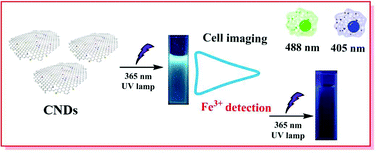Facile and green synthesis of carbon nanodots from environmental pollutants for cell imaging and Fe3+ detection†
Abstract
For the purpose of turning waste into treasure, acid orange 7 (AO7), a commonly used azo dye, has been explored as a precursor to synthesize carbon nanodots (CNDs) by a simple, green and economical route, without the utilization of strong acids or other oxidizers. Detailed characterization of the synthesized CNDs reveals their good water dispersibility, with a mean particle size of 3.54 nm and a thickness of 0.5–1.6 nm (2–4 layers). Importantly, the much-reduced biotoxicity and excellent fluorescence properties of the synthesized CNDs lead to their further potential applications in both bioimaging and selective detection of Fe3+ ions.



 Please wait while we load your content...
Please wait while we load your content...